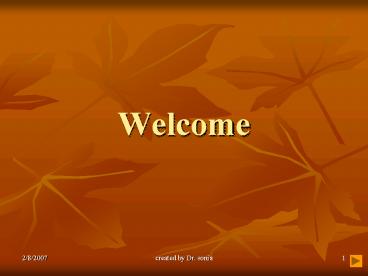Ayurvedic concepts on osteoporosis - PowerPoint PPT Presentation
1 / 33
Title: Ayurvedic concepts on osteoporosis
1
Welcome
2
Hitahitam sukham dukham aayustasya
hitatitammaanam ch tatroktam ayurveda sa uchyte.
3
Ayurvedic management concepts on Osteoporosis
4
Osteoporosis
- The word osteoporosis means porous bones due
to the deficiency of calcium and minerals. - In Ayurvda
- Asthi kshya
- There are seven types of dhatus found in the
body - 1) Ras 2) Rakt 3) Maas 4) Med 5) Asthi
- 6) Majja 7) Shukar.
- And asthi is the fifth dhatu found in the body.
5
Kshya means degeneration
- i.e breakage of integrity.
- and creation of space (kh vaigunya).
- Hence degeneration of bone is called
- Asthikshya.
6
There are three separate kind of dhatus
- Vatta
- Pitta
- Kaffa
- If they work in equilibrium then they mentioned
as dhatus. - And if they disproportionate in the ratio then
they mentioned as doshas.
7
There is degeneration of the bone i.e something
is breaking up kaffa dushti.
In Asthi kshya
No degeneration can occur without the
disruption of vatta vatta dushti.
8
Med dhatu earth air Asthi dhatu. Hence
asthi is adishthan(residence) of vatta and
kaffa.Hence associated doshas are vatta and
kaffa.
9
Types of vatta and kaffa effected
- Five types of vatta
- Pran
- Udan
- Sman
- Vyan
- Apan
- Five types of kaff
- Kledak
- Bodhak
- Tarpak
- Avlambak
- Shaleshmak
10
Properties of vatta and kaffa
- Vatta
- Dry (ruksh)
- Light (laghu)
- Mobile (chal)
- Kaffa
- Greasy(snigadh)
- Heavy (guru)
- Non motile (sthir)
11
Pathology of the disease
- Intake of Factors responsible for vatt increase
- Vitiated Vatta
- Asthi dhatu
- Kaffa shoshan
- Asthi kshya
12
Risk factors for Osteoporosis
- Thin physique.
- Low calcium intake.
- Family history.
- Early menopause .
- Cigarette smoking .
- Advanced age.
- Alcohol abuse.
- Gender.
- Bone structure.
- a lack of regular menstrual flow.
13
Most Effected Areas
- Wrist
- Hip
- Spine
14
Sign and symptoms
- Bone fracture.
- A loss of height.
- Gum inflammation and loosening of teeth.
- Acute lower backache.
- Nocturnal leg cramps.
- Restless behavior.
15
Ayurvedic management
- 1) Balance Vata because when disturbed
vata flow through the body nutrients - dont get delivered to the bones.
- 2) Balance Kapha because impaired kapha
metabolism disturbs the bone - rebuilding process and can create
osteoporosis even when nutrients are - available.
- 3) Balance Dhatus because it becomes very
important to restore their - equilibrium, particularly that of
asthi dhatu, which forms the bone mass. - 4) Correct Digestion because poor
digestion, leads to poor nutrition to the - bones.
- 5) Remove Body Blockages because the
buildup of toxins (ama) and - impurities block the flow of nutrients
to the bone. - 6) Strengthen Ojas because lack of ojas
(which is the final and most refined - product of digestion, metabolism,
absorption and assimilation) leads to - wasting conditions and contributes to
osteoporosis.
16
Two types of treatments we do
- Doshas treatment Disease treatment
- (doshgat chikitsa) (vyadhi gat chikitsa)
- Control of vatt Santarpan chikitsa
17
The prior methods we do
- 1) Snehan (oleation) is of two types
- a)Internal b) External
- 2) Swedan (Steam therapy)
18
Main methods of treatments
- Five types of main procedures
- Vaman
- Virechan
- Vasti 1) Niruhan 2)Anuvasan
- Rakatmokshan
- Nasya
19
Internal oleation
- It includes Oral administration of medicines.
- With jatharagni it will be digested and will
increase asthi dhatu.
20
External oleation the purpose of external
oleation is to make the doshas soft and
liquefied, it increases digestion. Abhyanga
using mahanarayan tail, is used for vata
pacification.
21
Steam bath since vatt is cold and steam is hot
both act opposite and it brings doshas into the
stomach.
22
Basti treatments Matra basti can be given which
is the miniature form of anuvasan vasti. It
digests in 6 hour in the body and can be given on
the daily basis.
23
Give basti eg. with ashvagandha tail
- Vasti after entering into intestines will extract
excess of vatta from the body. - So obstruction will be extracted out from the
body. - Hence flow of nutrients start flowing in the body.
24
Other patent medicines are
- Ashokarishta.Dashamularishta. Praval
pishti.Mahanarayan tail.Dashmool
ghritt.Triphala.Kukkutandatvak bhasm.
25
Katibasti is given for local inflammation and
pain withoils like Maha narayan tail.
26
Shiro dhara is given for the mental relax.
27
Food supplements and Rejuvenators
28
Effected Herbs and Medicines
29
Nutritional Therapy
- A balanced diet.
- Consume more of calcium-rich foods such as
skimmed milk,green leafy vegetables, orange
juices, apple juices. - Use of unsaturated fat such as sunflower and corn
oils. - Calcium supplementation during pregnancy,
breast-feeding and after menopause. - Eat foods that contain soy like soy milk.
30
Dos Yoga, exercise, positive attitude, rest,
exposure to sun, proper posture, take measures
to prevent fall, warm, heavy moist and slightly
oily foods that give you strength, mildly spiced.
31
DontTea, coffee, cigarette, alcohol, excess
salt and sugar, stress, soft drinks, cold drinks.
32
Prognosis is good with follow-up of proper
medical treatment.
33
THANKS.































